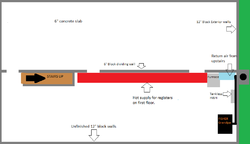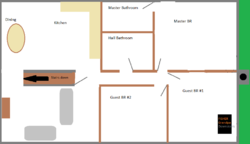So, I'm asking the same question as many others have before me.. But like the others, each situation is a little unique. I'm trying to move the wonderful heat my Fisher Grandpa puts off for me, upstairs.
My basement is unfinished and is built with 12" block all the way around. A 6" block dividing wall with 3 door openings seperates the two sides. The Fisher is in the far corner of the house, opposite end of the stair well. The stove is under the bedroom side of the house. The stairs also are facing the opposite direction of the stove as well. The stairs facing the opposite direction I think is what is hurting me the most.
The Fisher gets the entire basement area to about 72* even on the coldest nights, (lately 10* or colder). Which I think is pretty good for an unfinished basement, with exposed block walls and 6" of concrete. However the upstairs is usually only around 62, on the same cold nights. Right now I'm leaving the basement stair door open, obviously.. And have my furnace fan on circulate to hopefully draw the heat up the stairs.
My question is, what other/better methods could I use to get more of the heat upstairs?
I've thought of a few floor registers in the living room near the stair well will let up more heat. I know finishing the basement will help a tremendous amount, which will happen, just not ready for that at this time.
I've also thought about cutting another return in my return duct in the basement at the unit to draw some of the warm air from the stove into and disperse it thru out the house. I know this is frowned upon by many but these are just ideas for now. Also my return duct/furnace is about 10' from the stove now.
I've attached a diagram to help explain the basement layout.
Thanks for your ideas and input. It is greatly appreciated all.

My basement is unfinished and is built with 12" block all the way around. A 6" block dividing wall with 3 door openings seperates the two sides. The Fisher is in the far corner of the house, opposite end of the stair well. The stove is under the bedroom side of the house. The stairs also are facing the opposite direction of the stove as well. The stairs facing the opposite direction I think is what is hurting me the most.
The Fisher gets the entire basement area to about 72* even on the coldest nights, (lately 10* or colder). Which I think is pretty good for an unfinished basement, with exposed block walls and 6" of concrete. However the upstairs is usually only around 62, on the same cold nights. Right now I'm leaving the basement stair door open, obviously.. And have my furnace fan on circulate to hopefully draw the heat up the stairs.
My question is, what other/better methods could I use to get more of the heat upstairs?
I've thought of a few floor registers in the living room near the stair well will let up more heat. I know finishing the basement will help a tremendous amount, which will happen, just not ready for that at this time.
I've also thought about cutting another return in my return duct in the basement at the unit to draw some of the warm air from the stove into and disperse it thru out the house. I know this is frowned upon by many but these are just ideas for now. Also my return duct/furnace is about 10' from the stove now.
I've attached a diagram to help explain the basement layout.
Thanks for your ideas and input. It is greatly appreciated all.

Last edited by a moderator:


